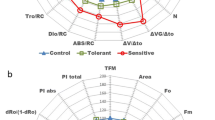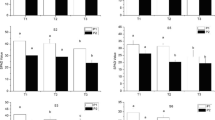Summary
The effect of repeated short periods of water stress during the hot season on six potato cultivars was investigated. The number of tubers per plant tended to decrease in response to water stress in cultivars which had more than 9.8 tubers per control plant (Désirée, Alpha, Elvira). In the other cultivars, no consistent effect of water stress on tuber number per plant was observed. Except for Spunta, the percentage of large tubers (>60 g/tuber) was reduced in the water-stressed plants. Consequently, the average weight of these tubers was greater than that of tubers harvested from the unstressed plants, indicating that the sink force of the individual tuber was not impaired by drought. However, tuber yield per plant was reduced due to drought in all cultivars tested.
The smallest decrease in dry matter accumulation as well as the greatest lowering of the osmotic potential in the tuber tissue was found in Alpha. No consistent effect of water stress on the percentage of misshapen and sprouting tubers was observed, indicating the marked effect of the high temperature on these traits.
Zusammenfassung
Bei Trockenheit stieg die Zahl der Knollen pro Pflanze bei denjenigen Sorten an, die eine relativ hohe Knollenzahl bei den Kontrollpflanzen hatten (Désirée, Alpha, Elvira). Andere Sorten mit geringeren Knollenzahlen bei unbelasteten Pflanzen zeigten diese Erscheinung nicht (Up-to-Date, Troubadour, Spunta; Tab. 1). Das Frischgewicht der Knollen pro Pflanze war bei den belasteten Pflanzen aller Sorten reduziert, ebenso, ausser bei Spunta, der Prozentsatz grösserer Knollen (>60 g/Knolle; Tab. 1). Die Aufnahmefähigkeit der einzelnen Knollen wurde durch kurze Trockenperioden nicht beeinträchtigt, da bei den durch Wassermangel belasteten Pflanzen grosse Knollen erhalten wurden (Tab. 1).
Bei der Ernte ergaben sich hohe Anteile missgestalteter und keimender Knollen; ein einheitlicher Effekt des Wassermangels auf diese Merkmale liess sich nicht beobachten (Tab. 1).
Der Gehalt an Trockenmasse in den Knollen sank bei Up-to-Date und Troubadour deutlich und stieg bei Alpha an (Tab. 2). Dies bewirkte, im Vergleich zu den anderen Sorten, bei Alpha einen grösseren Ertrag an Trockenmasse (Tab. 1). Bei allen Sorten ergab sich bei Wassermangel in den Knollen ein erhöhter Gehalt an voll löslichen Stoffen (Äquivalente der Saccharose; Tab. 2). Der stärkste Anstieg ergab sich bei Alpha, was auf die Senkung des osmotischen Potentials des Knollengewebes unter trockenen Bedingungen zurückgeführt werden könnte (Tab. 2). Beim Gehalt an löslichen Proteinen war kein einheitlicher Effekt zu beobachten (Tab. 2).
Alpha scheint an kurze Trockenperioden am besten adaptiert zu sein, während Up-to-Date und Troubadour von den 6 geprüften Sorten am wenigsten geeignet erscheinen.
Résumé
Le nombre de tubercules par plante tend à diminuer sous l'influence d'un déficit hydrique, avec les variétés dont les plantes témoins présentent un nombre relativement élevé de tubercules (Désirée, Alpha, Elvira); par contre, ceci n'a pas été observé avec les variétés dont les plantes, en absence de déficit hydrique, ont un nombre plus faible de tubercules (Up-to-Date, Troubadour, Spunta) (tableau 1).
Le poids frais des tubercules par plante diminue pour toutes les variétés en cas de déficit hydrique, ainsi que le pourcentage des gros calibres (>60 g/tubercule), à l'exception de la variété Spunta (tableau 1). La force d'absorption des tubercules individuels n'est pas modifiée en cas de courtes périodes de sècheresse, étant donné la présence de gros tubercules sur des plantes ayant souffert d'un manque d'eau (tableau 1).
Des pourcentages élevés de tubercules difformes et germés sont observés à la récolte, mais ceci sans lien véritable avec le déficit hydrique (tableau 1). Le pourcentage de matière sèche des tubercules diminue de façon marquée avec Up-to-Date et Troubadour et augmente avec Alpha (tableau 2); ceci permet de maintenir un rendement en matière sèche par tubercule relativement plus élevé avec Alpha qu'avec les autres variétés (tableau 1). Les tubercules de toutes les variétés ont un taux de substances solubles (équivalents du saccharose) plus élevé, en cas de déficit hydrique des plantes (tableau 2). La teneur la plus forte est obtenue avec la variété Alpha, ce qui semble contribuer à la diminution du potentiel osmotique des tissus du tubercule en conditions sèches (tableau 2). Le déficit hydrique n'a pas une influence significative sur la teneur en protéines solubles (tableau 2).
La variété Alpha semble la mieux adaptée aux courtes périodes de dessèchement, tandis que Troubadour et Up-to-Date sont les 2 variétés les moins adaptées.
Similar content being viewed by others
References
Bodlaender, K. B. A., 1963. Influence of temperature, radiation and photoperiod on development and yield. In: The growth of the potato. Proceedings of the 10th Easter School of Agricultural Science, University of Nottingham, pp. 199–210.
Chiappelli, F., A. Vasil & D. F. Haggerty, 1979. The protein concentration of crude cell and tissue extracts as estimated by the method of dye binding: Comparison with the Lowry method.Analytical Biochemistry 94: 160–165.
Levy, D. & Y. Itzhak, 1978. Vegetative development and tuber yields of potato vars. Blanka, Désirée and Up-to-Date grown in the spring.Hassadeh, 58: 1767–1771 (in Hebrew, English summary).
Levy, D., 1982. A method of screening for heat tolerance of potatoes and its possible contribution to potato breeding in Israel.Hassadeh 62: 1198–1201 (in Hebrew, English summary).
Levy, D., 1983. Varietal differences in the response of potatoes to repeated short periods of water stress in hot climates. I. Turgor maintenance and stomatal behaviour.Potato Research 26: 303–313.
Loon, C. D. van, 1981. The effect of water stress on potato growth, development and yield.American Potato Journal 58: 51–69.
Marinus, J. & K. B. A. Bodlaender, 1975. Response of some potato varieties to temperature.Potato Research 18: 189–204.
Nichols, D. F. & R. H. Ruf, Jr., 1967. Relation between moisture stress and potato tuber development.Proceedings of the American Society of Horticultural Science 91: 443–447.
Robins, J. S. and C. E. Domingo, 1956. Potato yield and tuber shape as affected by severe soil moisture deficits and plant spacing.Agronomy Journal 48: 488–492.
Roztropowicz, S., 1978. Some aspects of Polish physiological and agrotechnical research on the potato. In: Survey Papers, 7th Triennal Conference of the EAPR (Warsaw, Poland), pp. 35–60.
Shimshi, D. and A. Livne, 1967. The estimation of the osmotic potential of plant sap by refractometry and conductimetry: A field method.Annals of Botany 31: 505–511.
Smith, J., 1977. The effect of irrigation frequency and seed rate on the yield of main crop potatoes from peaty loam soils.Experimental Husbandry 33: 4–11.
Steckel, J. R. A. & D. Gray, 1979. Drought tolerance in potatoes.Journal of Agricultural Science 92: 375–381.
Author information
Authors and Affiliations
Additional information
Contribution from the Agricultural Research Organization, The Volcani Center, Bet Dagan, Israel, No 310-E, 1981 series. This investigation was sponsored by a grant from the Ministry for Development Cooperation of the Netherlands.
Rights and permissions
About this article
Cite this article
Levy, D. Varietal differences in the response of potatoes to repeated short periods of water stress in hot climates. 2. Tuber yield and dry matter accumulation and other tuber properties. Potato Res 26, 315–321 (1983). https://doi.org/10.1007/BF02356153
Accepted:
Issue Date:
DOI: https://doi.org/10.1007/BF02356153




